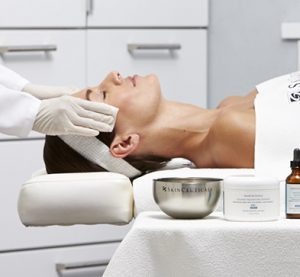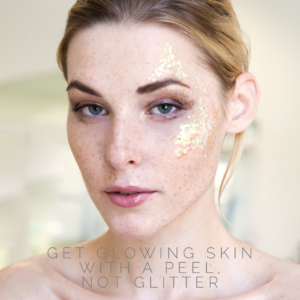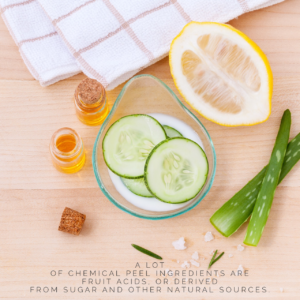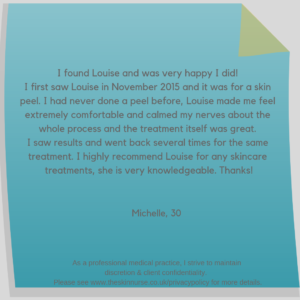Chemical Skin Peels
An easy way to get your glow back!
Chemical skin peels remove the superficial layers of dead skin to reveal your fresh, smooth, clear skin again. Naturally occurring enzymes (often from fruit or sucrose) are used to breakdown stubborn proteins which prevent our skin form renewing itself.
I know that the idea of having a ‘chemical’ applied to your skin may sounds pretty harsh, but rest assured that (in the right hands) they are very safe and extremely effective.
Just as a warning – there is a lot of information on this page! If you’d prefer to simply book in for a consultation with me, I will explain all the bits you need to know, alternatively, happy reading…
Chemical Skin Peels are used to positively address issues such as:
- Hyper-pigmentation

- Dull and sluggish skin
- Rough texture
- Open pores
- Fine lines and wrinkles
- Congestion
- Uneven skin tone
- Rosacea
- Acne
- Acne scarring
The benefits of chemical skin peels
- Removal of dead skin cells – hello fresh clear skin!
- To kick-start skin-cell turnover, allowing skin to work better again
- Pigmentation breakdown, ta-ta bron spots…
- Deep cleansing
- Clears congested pores (blackheads anyone?)
- Smooths and refines your skin’s surface just you wait til’ you feel it afterwards ‘smooth as a baby’s bum!
- Scar tissue can be softened
- Tightens and firms your skin
- Reduce inflammation
- Restores the barrier function of your skin
- Increases your hydration levels
The real benefits of a chemical skin peel
- Your glowing smooth skin will not only look amazing but you’ll feel great!
- Your make up will go on better
- You might not actually need make up
- You’ll have a little spring in your step
What to expect during your chemical skin peel
Once you’re comfortable on the treatment couch and your skin has been assessed, your skin will be cleansed. Some areas (your eyes and lips) will be protected with a barrier cream, then the peel will be painted on with a light brush. The peel will be left on for a few minutes and your skill will be continually assessed throughout. It may feel a little prickly whilst its on (usually just a few minutes). The peel will then be removed and calming, nourishing products will be applied, along with a
Do chemical skin peels hurt?
You may feel a bit of tingling and heat. If you have a stronger peel you may feel itching and a little discomfort. This is only for a few minutes whilst the peel is penetrating the skin. A fan is usually used to cool you during these few minutes.
How will you look and feel after a chemical skin peel?
If you have a gentle superficial peel your skin will feel fresh and hydrated. If you have a stronger peel, your skin might be a little flush and inflamed. You may have some redness.
How soon will you see results?
If you have a mild skin peel you will see the glowing results immediately. If you have a deeper skin peel then you will se the results after your skin has recovered, usually 3-7 days afterwards.
Are there any side-effects from having a chemical skin peel?
Redness, dryness and some peeling are common with medium depth skin peels, and this usually resolves after a few days if you follow the aftercare guidance.
The different types of chemical skin peels
Three common descriptions are: superficial peel, medium peels and deep peels, categorised by the strength of the acid solution used in the peel and how deeply they penetrate the skin. Deeper peels penetrate the skin further and would require greater recovery time.
‘Down-Time’ is how long your skin will be recovering for, usually the length of time you won’t want to wear make-up.
Mild peels – These are great for a freshen up, to give your skin a healthy glowing boost before a special do or when you just want to liven up a dull skin tone. Excellent for deep cleansing and exfoliation. These peels are often based on Alph hydroxy acids.
Examples of mild peels:
Mandelic acid is great for red skin issues, it helps to calm and reduce inflammation and helps rosacea.
Glycolic acid – A AHA, gentle and effective at loosening dead skin cells to exfoliate and smooth the skin. A good all-round skin refresher to get your glow on.
Medium peels – These are good for more specific skin issues such as acne scarring,  fine lines. pigmentation, but will take a little longer to recover from, usually 3-7 days.
fine lines. pigmentation, but will take a little longer to recover from, usually 3-7 days.
Examples of medium depth peels:
Salicylic Acid is used specifically for people who suffer from Acne, it helps to not only clear the bacteria but also to reduce the amount of oil thats produced.
Jessners peel is a combination of salicylic acid, lactic acid and resorcinol used to treat hyper-pigmentation, melasma, acne and crepey skin.
TCA – Trichloroacetic Acid will improve hyper pigmentation, texture, skin tone, scarring, Ice pick scars and fine wrinkles. It will also help to remove discoloration, such as age spots. TCA stimulates the skin to remodel itself and is the strongest peel I offer.
Pyruvic acid is used to treat a wide range of skin issues, including lines, wrinkles, hyper pigmentation issues as well as excessively oily skin.
Deep peels are often a one off treatment and given under anaesthetic. They are very costly, very risky and come with alot of down time (weeks to months). An example would be the Phenol chemical peel. I don’t believe this is a necessary treatment to have nowadays as there are many laser options which give just as good results without all the risk and long term down-time.
Different chemical peels are suited to different skin types and different skin issues. During your skin assessment, I will choose whats best for you.
Which skin peels are available?
I offer a variety of chemical skin peels, including the acids mentioned above, because I like to have a decent ‘tool box’ to work from. Our skin goes through changes at different times and it needs to be assessed at each appointment prior to any skin peel or procedure. i use peels from Obagi, Skinceuticals and Ennerpeel, to ensure I can treat all the skin concerns and skin types I see.
How to prepare for a chemical skin peel
To get the best results from your procedure you need to prepare your skin at home by using a topical antioxidant and SPF daily. I would also recommend using a hydrating serum too – this will help your skin to recover better and be more resilient.
You must get used to avoiding sun exposure if you’re considering having chemical peels, this mean before and after a chemical peel…
Risks of chemical skin peels
Hyper-pigmentation – if you don’t protect your skin from UV damage.
If you have had cold sores in the past – a chemical peel may trigger this. Medication to treat this is before a peel is recommended.
Who cannot have skin peels?
People who do not wear a topical antioxidant and broad-spectrum SPF every single day.
If you have any skin infection or dermatitis in the area.
If you are allergic to Aspirin you cannot have a salicylic acid peel.
If you’ve used Isotretinoin or hydroquinone in the last six months.
Chemical Skin Peel Aftercare advice
After your peel you may notice that the skin is more red than usual, you may also notice that the skin feels tight or dry, and you may experience some very mild flaking of the skin for a few days. It is very important to use a broad-spectrum sunscreen every day after your procedure. Find one you love and use it every day. Your future self with thank you! You will need to avoid skin-makeup until your skin has completely recovered.
- Do not use any other skin products except those advised by your practitioner.
- Do not pick any spots or peel off any flaky skin.
- Do not use Alpha Hydroxy Acids or Beta Hydroxy Acids on your skin for 48 hours.
- It is imperative that you use a sunscreen with an SPF of at least 30 and avoid direct sunlight for at least one month.
- Patients with hypersensitivity to the sun should take extra precautions to guard against exposure immediately following the procedure, as they may be more sensitive following the peel.
- When washing your face, do not scrub, use a gentle cleanser for sensitive skin.
- Apply a light moisturiser as often as needed to relieve dryness and tightness.
- Do not have any other facial treatments for at least one week after the peel,
How much to chemical skin peels cost?
Mild skin peels cost from £95.00
Medium skin peels cost from £150.00
How many peels will you need?
Whilst you will see some general benefits after a single skin peel. I recommend a course of six peels, two to four weeks apart. This will give you the best results. As superficial peels are gentler, the full benefits of the peel build up over a course of six treatments.
Six weeks prior to your peel:
Stop any products containing retinol eg. Retin-A, Renova, Differin (Adapalene 0.1%) Tazorac. The following products are amazing and will improve the results of your peel and are especially important for those going on a course of peels.
- Retexturing Activator is a revolutionary resurfacing and replenishing serum, it exfoliates AND hydrates, but is super gentle. It activates the skin’s regeneration response, diminishing surface lines and transforming the skin’s fabric into a smoother, softer texture. The Retexturing activator can be continued during and after your course of peels to further enhance the effect of your peel. You can buy it here.
- Pigment Regulator is used instead of the Retexturing Activator if you are having a chemical peel for excess pigmentation. The Pigment Regulator lightens and reduces existing skin pigments, improves overall skin tone, and protects skin from future discolourations. The formulation combines precise concentrations of kojic acid and emblica to improve uneven skin tone. The Pigment Regulator inhibits the production of excess melanin, prevents excess melanin from travelling to the skin’s surface, and breaks up melanin clusters on the skin’s surface to diminish existing discolouration. Have a peek here.
- Antioxidant serums such as CE Ferulic, Phloretin CF or Serum 10 provide advanced skin protection by neutralising environmental and sun skin damage. They help build collagen, and provide unmatched antioxidant protection, plus build up your skins resilience so your skin peel down-time will be reduced. Have a look at the ones I use and recommend here.
- Sunscreens are essential and should be used in combination with an antioxidant to protect the skin from the ageing effects of ultraviolet sun damage. It is very important to use a sunscreen, a minimum of SPF 30, and to avoid sun exposure following a skin peel, and during the treatment period for up to four weeks, as the delicate post-peel skin can be more easily sun damaged and this can lead to excessive skin pigmentation. The sunscreens I use and love are here.
One week before peel:
Avoid electrolysis, waxing, hair removal creams and laser hair removal for an entire week prior to your chemical peel.
24 hours before your peel:
Stop using any exfoliating products or products that may be drying or irritating, including products containing alpha or beta hydroxy acids or benzoyl peroxide (a treatment for acne). On the day of your peel, please do not apply makeup on the face other than eyes or lips.
Will I be able to go out in the sun after a chemical skin peel?
Your skin will be more susceptible to sun damage up to 4 four weeks after the treatment as the peel resurfaces the skin. I recommend that a sun protection cream of at least SPF 30 is worn permanently to reduce the effects of sun damage and ageing. If travelling to a hot climate, I recommend a skin peel is postponed until you return home from your journey, if this is not possible then you need to reapply your sunscreen every 4 hours whilst outside.
Are the skin peels good for scarring?
Yes, skin peels can help reduce scarring. They can be especially effective against acne scarring, however it will take a course at least to achieve optimum results.
Will a chemical peel get rid of brown spots?
Pigmentation caused by sun damage can be removed or reduced by skin peels. However, there is a small risk that a skin peel could cause hypopigmentation (lighter areas) marks to the skin. Dark skins, such as Asian and black skins are more prone to this damage; they can still be treated with preparation to the skin before the peel.
I know there is alot of information on this page, so well done if you made it all the way down here! If you have any questions, please do drop me a email or book yourself in for a consultation.
